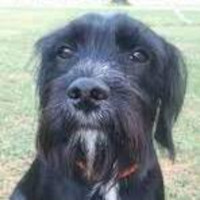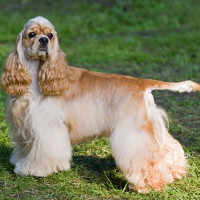Appearance of the Schnocker
|
| Your Hybrid Schnocker is a mix of Miniature Schnauzer and American Cocker Spaniel and, as such, may inherit appearance traits from either or both parent breeds. Breeders and owners of the Hybrid Schnocker describe it as a small to medium-sized dog, measuring 30.5 to 38 centimeters and weighing 7 to 11 kilos. He is slender, with long legs, large webbed feet and floppy ears. Its gentle face has dark eyes, a black nose and a beard. Its coat can be very variable, depending on the breed of the dominant parent, it can be short or long, straight or wavy and shaggy, coarse or soft, with longer hair around the legs, eyebrows, ears, face and feet. Common colors are black, brown, blond, white, gray and champagne. The tail can vary in length. |
Temperament of the Schnocker
|
| Your Hybrid Schnocker is a mixed breed and can inherit temperament qualities from either or both of its parent breeds, the Miniature Schnauzer and the American Cocker Spaniel. Breeders and owners of the Schnocker have described its temperament as gentle, intelligent, affectionate and cuddly. He can suffer from separation anxiety in certain situations, but if the Schnauzer parent has dominance in the temperament's organic mix, he'll probably handle it better. He loves to be the center of attention and needs lots of it. He'll beam with pleasure when he has company because he's so cute they can't help but smother him with attention, but beware of those little “pee” spots resulting from excitement when company arrives. The peeing problem is alleviated when there's only family around. He's very sensitive and will quickly become attached to you, perhaps even faster than you'll become attached to him. He's easy to train, as he has a strong desire to please. He will need to be properly socialized from an early age to ensure that he gets on well with children, although some supervision is recommended when in the presence of young children. Young children generally don't know how to touch and play with him, so it's best to teach them the safest ways to interact with him. In addition, he tends to bark occasionally or frequently, so be aware that extra training may be needed to control him, especially if you live in a noise-restricted area. |
Needs and activities of the Schnocker
|
| Your Hybrid Schnocker is a mildly active little dog. He'll be happy to sit and snuggle with you while you read or watch TV, that's for sure. But he needs exercise and will love a few daily walks, playing and romping in the dog park or fenced garden, and taking part in interactive games such as fetch, frisbee, fly ball and obedience and agility training. He's small enough to live in an apartment or condo without any problems, provided he gets the exercise he needs to keep him happy, fit and healthy. He can also live very well in a family home, with or without a fenced yard, in an urban or rural environment. He can tolerate most climates, but extra protection and precautions may be needed in higher temperatures. |
Maintenance of the Schnocker
|
| Your Schnocker hybrid is considered to be in the moderate maintenance category, with a coat that will need brushing several times a week to remove loose hairs, debris, knots and tangles, and to distribute the vital oils throughout the coat that are necessary to keep it beautiful and healthy. It is considered a minimal shedder and can be hypoallergenic, although only the Miniature Schnauzer parent brings this characteristic to the biological mix. He should be bathed only when necessary to avoid drying out the vital oils needed to keep his coat waterproof and weather-resistant. He's prone to ear infections, so you'll need to check his ears every week and clean them if necessary with absorbent cotton and a cleaning product approved for canine ears. Also check his toenails every week and trim them if necessary, unless he's able to maintain them through normal physical activity. Regular brushing is recommended for all dog breeds, and the Hybrid Schnocker is no exception. We recommend brushing at home at least two or three times a week to prevent the development of periodontal disease and the tooth loss that can result. Hybrids fall into the low-slobber, low-smell category. |









 English (United Kingdom)
English (United Kingdom)